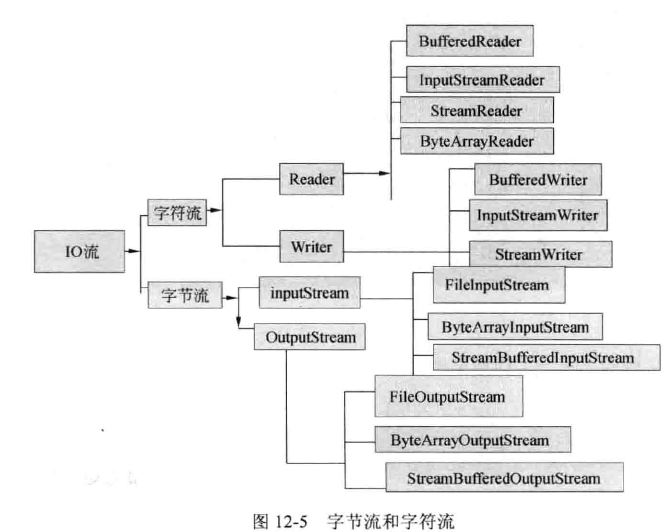学习内容:
1、流和流的分类
在Java中,每个流都是一个对象。
流通常分为两种:输入流(InputStream) 和输出流(OutputStream)。
对于输入流,只要从流当中不停地把字节取出即可;而对于输出流,只要把准备好的字节串传给它即可,如图所示。

java.io包中的stream类根据其操作对象的类型可分为两大类:字符流和字节流。
(1) Java的字节流
InputStream 是所有字节输入流的父类,而 OutputStream 是所有字节输出流的父类。
(2) Java 的字符流
Reader 是所有读取字符串输入流的父类,而 Writer 是所有输出字符串的父类。
结合开始所说的输入/输出流,出现了一个小框架:
字节流 字符流
输入流 InputStream Reader
输出流 OutputStream Writer
字节流和字符流如图所示。

从该图可以看出,在Java中,所有的字节流都是以Stream结尾的,所有的字符流都是以Reader/Writer结尾的。
2、字节流和字符流
Java对于流的操作可以分为字节流和字符流。字节流主要操作字节序列的对象,如对二进制文件、图片及影像文件的操作;字符流主要操作字符序列的对象,如对文本文件等。
(1)字节流
输出字节流OutputStream
I/O中输出字节流的继承图所示,可以看出以下特点:
1.OutputStream 是所有的输出字节流的父类,它是一个抽象类。
2.ByteArrayOutputStream、 FileOutputStream 是两种基本的介质流,它们分别向Byte数组和本地文件中写入数据。
3.ObjectOutputStream 和所有 FilterOutputStream 的子类都是装饰流。
使用字节输出流OutputStream定义如下:
public abstract class OutputStream extends object implements Closeable,Flushable
在此类中定义了如下的几个常用方法:
1.关闭流: public void close() throws IOException
2.写一组数据: public void write(byte[] b) throws IOException
3.一个数据: public void write(int b) throws IOException。
但是要想将Outputream实例化,且进行文件操作,就要使用FileOutputStream 子类。
4.构造: public FileOutputStream(File file) throws FileNotFoundException
示例:使用字节流输出内容
import java.io.FileOutputStream;
import java.io.IOException;
import java.io.OutputStream;
public class FileOutStreamDemo {
public static void main(String[] args)throws IOException {
out();
}
public static void out()throws IOException{
OutputStream out=new FileOutputStream("D:/Hello.txt");
String info="Hello Java!";
byte[] buf=info.getBytes();
out.write(buf);
out.close();
}
}

示例:使用字节流追加内容
该程序还会有一个问题,如果在关闭前程序出现异常,文件就不能关闭,所以应该将关闭放在finally 里,不管程序有无异常,都应该关闭流,代码修改如下。
import java.io.FileOutputStream;
import java.io.IOException;
import java.io.OutputStream;
public class FileOutStreamDemo {
public static void main(String[] args)throws IOException {
out();
}
public static void out(){
OutputStream out=null;
try {
out=new FileOutputStream("D:/Hello.txt",true);
String info="Hello PHP!";
byte[] buf=info.getBytes();
out.write(buf);
}catch(IOException e) {
e.printStackTrace();
}finally {
try {
if(out!=null) out.close();
}catch(IOException e) {
e.printStackTrace();
}
}
}
}

输入字节流InputStream
I/O中输入字节流的继承图所示,可以看出:
1.InputStream 是所有的输入字节流的父类,它是一个抽象类。
2.ByteArrayInputStream、 StringBufferInputStream. FileInputStream 是三种基本的介质流,它们分别从Byte数组、StringBuffer 和本地文件中读取数据。 3.ObjectInputStream和所有FilterInputStream的子类都是装饰流。
用户可以使用InputStream完成输入字节流的操作,此类定义如下。
public abstract class InputStream extends object implements Closeable
InputStream类中定义的方法如下。
关闭: public void closeO throws IOException
读取一个字节: public abstract int read() throws IOException
读取一组内容: public int read(byte[] b) throws IOException
读取文件,使用子类FileInputStream
示例:使用字节流读文件内容
import java.io.FileInputStream;
import java.io.IOException;
import java.io.OutputStream;
public class FileInputStreamDemo {
public static void main(String[] args)throws IOException {
in();
}
public static void in() {
FileInputStream in=null;
try {
in=new FileInputStream("D:/Hello.txt");
byte[] buf=new byte[1024];
int len=-1;
while((len=in.read(buf))!=-1) {
String s=new String(buf,0,len);
System.out.println(s);
}
}catch(IOException e) {
e.printStackTrace();
}finally {
try {
if(in!=null) in.close();
}catch(IOException e) {
e.printStackTrace();
}
}
}
}
输出结果:Hello Java!Hello PHP!
(2)字符流
Reader与Writer和其子类都是处理字符流的相关类。字符流可以对流数据以一个字符的长度为单位来处理,并进行适当的字符编码转换处理,- -般字符流都用来操作纯文本文件。
字符输出流
Writer是字符输出流,该类是一个抽象类,所以需要使用子类FileWriter类来操作文件。
示例:字符输出流写入内容
import java. io. FileWriter;
import java.io. IOException;
public class WriteDemo {
public static void main(String[] args) throws IOException {
write() ;
}
public static void write() throws IOException{
FileWriter fw =new FileWriter ("D:/Hello.txt") ;
fw. write("Hello C++!");
fw.close() ;
}
}
若在文件中追加内容,且原内容不被覆盖,则
import java. io. FileWriter;
import java.io. IOException;
public class WriteDemo {
public static void main(String[] args) throws IOException {
write() ;
}
public static void write() throws IOException{
FileWriter fw =new FileWriter ("D:/Hello.txt",true) ;
fw. write("Hello C++!");
fw.close() ;
}
}
字符输入流
Reader是一个字符输入流,但它是-个抽象类,所以必须由其子类FileReader来实例化。
示例:使用字符输入流读取内容
import java. io. FileReader;
import java.io. IOException;
import java. io. Reader;
public class WriteDemo {
public static void main(String[] args) throws IOException {
reader() ;
}
public static void reader() throws IOException{
Reader r =new FileReader ("D:/Hello.txt") ;
char[] buf=new char[1024];
int len=0;
while((len=r.read(buf)!=-1){
String s=new String(buf,0,len);
System.out.println(s);
}
r.close();
}
}
输出结果:Hello C++!
(3)字节流与字符流的区别
字节流与字符流的区别主要体现在以下两点:
1.读写单位不同:字节流以字节(8bit) 为单位,字符流以字符为单位,根据码表映射字符,一次可能读多个字节。
2.处理对象不同:字节流能处理所有类型的数据(如图片、avi等), 而字符流只能处理字符类型的数据。
结论:只要是处理纯文本数据,就优先考虑使用字符流,此外,都使用字节流。
遇到的问题:
对字节流不理解
明天要学习的内容:
过滤流、内存操作流、缓冲流
